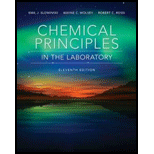
Concept explainers
Finding the volume of a flask.
A student obtained a clean, dry glass-stoppered flask. She weighed the flask and stopper on an analytical balance and found the total mass to be
a. First we need to obtain the mass of the water in the flask. This is found by recognizing that the mass of a sample is equal to the sum of the masses of its parts. For the filled, stoppered flask:
Many mass and volume measurements in chemistry are made by the method used in la. This method is called measuring by difference, and is a very useful one.
b. The density of a pure substance is equal to its mass divided by its volume:
The volume of the flask is equal to the volume of the water it contains. Since we know the mass and density of the water, we can find its volume and that of the flask. Make the necessary calculation.
Interpretation:
The volume of the stoppered flask which contains water with density equals to
Concept introduction:
The division of mass of a substance to its volume is known as density of that substance. The expression that is used to represent the density of any substance is given below.
The SI unit of density is
Answer to Problem 1ASA
The volume of the stoppered flask which contains water with density equals to
Explanation of Solution
The given total mass of empty flask with its stopper is
The observed mass of the stoppered flask when it is filled with water is
The density of water is
The mass of water
Firstly, the mass of water that is present in the stoppered flask must be calculated.
The mass of the filled stoppered flask is calculated by the expression given below.
The above expression is rearranged to calculate the mass of water that is present in the stoppered flask as given below.
Substitute the values of empty flask and filled flask in the above expression.
Thus, the mass of water is
The density of any substance is calculated by the expression given below.
The above expression is rearranged to calculate the volume of water that is present in the stoppered flask as given below.
Substitute the values of mass and density of water in the above expression.
So, the volume of water is
As, the volume of flask is equal to the volume of water present in it, therefore, the volume of stoppered flask is also equal to
The volume of the stoppered flask that contains water is
Want to see more full solutions like this?
Chapter 1 Solutions
Chemical Principles in the Laboratory
- Hi can you please help me solve this problem? thank youarrow_forwardAn electrode process takes place at a metal-solution interface. Indicate the current condition that must be met for Faradaic rectification to occur.arrow_forwardAt a metal-solution interface, an electron is exchanged, and the symmetry factor beta < 0.5 is found in the Butler-Volmer equation. What does this indicate?arrow_forward
 ChemistryChemistryISBN:9781305957404Author:Steven S. Zumdahl, Susan A. Zumdahl, Donald J. DeCostePublisher:Cengage Learning
ChemistryChemistryISBN:9781305957404Author:Steven S. Zumdahl, Susan A. Zumdahl, Donald J. DeCostePublisher:Cengage Learning
 Chemistry: The Molecular ScienceChemistryISBN:9781285199047Author:John W. Moore, Conrad L. StanitskiPublisher:Cengage Learning
Chemistry: The Molecular ScienceChemistryISBN:9781285199047Author:John W. Moore, Conrad L. StanitskiPublisher:Cengage Learning Chemistry for Engineering StudentsChemistryISBN:9781337398909Author:Lawrence S. Brown, Tom HolmePublisher:Cengage Learning
Chemistry for Engineering StudentsChemistryISBN:9781337398909Author:Lawrence S. Brown, Tom HolmePublisher:Cengage Learning



